District Plan Hauraki Gulf Islands Section - Proposed 2006
(Notified version 2006)
Street index |
Planning maps |
Text |
Appendices |
Annexures |
Section 32 material |
Plan modifications |
Help |
Notified - Home |
Decision - Home
Appendix 15 - Guidelines for works within the vicinity of trees
1.0 Introduction
2.0 How trees function
3.0 Damage to trees
4.0 Protection and care of trees
1.0 Introduction
These guidelines will assist users to comply with the
controls in the Plan that protect trees.
Trees have an important ecological, environmental, and
cultural role. They have an important contribution to make in the sustainable
management of natural and physical resources of the Hauraki Gulf. Collectively
they endow the landscape with distinctive environmental quality and
charm.
The environmental or practical relationship between
people and trees is fundamental to existence. Often development pressure
threatens the continued existence of trees. With this in mind suitable
guidelines are required for work within the vicinity of trees.
These guidelines are designed to give a brief overview
of how a tree functions, how the different above and below ground parts
of a tree are interdependent, and how various activities may cause significant
damage to trees. Suitable mitigation measures are described in these
guidelines to assist in deciding the best ways to provide protection
to trees, and in particular to their root systems.
Early consultation with the council and qualified arborists
is also recommended.
2.0 How trees function
A tree is a dynamic living organism. All of the various
parts and functions of a tree are interdependent, and understanding
these parts and functions is important to prevent unnecessary damage.
The trunk, crown and roots function together as a balanced system in
a vigorous healthy tree. Any damage to the above or below ground tree
parts will upset this balance and cause a net reduction in overall tree
health.
Trees are often viewed as only trunks, branches and
leaves, however a major portion of every tree, the roots, are unseen.
The root system is generally overlooked and misunderstood. One of the
purposes of this annexure is to place importance on protecting the roots
of trees.
2.1 Tree parts
above ground
2.1.1 Trunk and large
branches
The trunk and branches of a tree serve three primary
functions:
-
structural support
-
storage of food reserves
-
transport of essential substances.
These functions are carried out by the various tissues
(as shown on figure A15.1), which make up the trunk and branches:
-
bark
-
phloem
-
cambium
-
xylem
-
sapwood
-
heartwood.
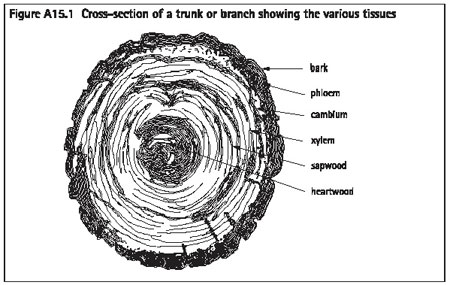
Bark is the outermost layer of tissues. Bark provides
some measure of defence against physical and biological damage, and
helps moderate trunk and stem temperatures.
Phloem tissue is a vascular system located between the
bark and cambium. Phloem is a series of connected cells designed to
transport growth regulators, sugars, and carbohydrates throughout the
tree.
Cambium is an active growing layer of cells which are
dividing to produce new vascular tissue which is either phloem or xylem.
Xylem tissues form inward from the cambial layer, developing
a second vascular system. Xylem is responsible for the uptake of water
and essential elements from the roots to the leaves. Xylem becomes the
wood of the tree, providing structural support and a volume of tissues
used to store food reserves.
Sapwood is the outer and active layers of wood, which
provide transport, storage, structural support, and protection and defence
against decay pathogens.
Heartwood is the inner and nonconducting layers of older
xylem. The main function of heartwood is to provide structural support
for the tree.
The vascular system exists just beneath the bark of
a tree, and is easily damaged. Any damage to the vascular system can
have a major negative effect on tree health.
2.1.2 Tree crown
Twigs and smaller branches consist of the same tissues,
serving the same functions as the trunk and branches of a tree. They
also serve as the primary growth sites for the buds which develop into
leaves, flowers, and fruits.
The normal growth pattern of smaller branches, twigs,
and leaves maximises the total crown area available for photosynthesis
and transpiration. Photosynthesis and transpiration are the primary
functions of leaves.
2.2 Tree parts
below ground
2.2.1 Tree root functions
and growth patterns
Any construction process that disrupts or interferes
with tree root systems will have an adverse effect on tree health.
Roots serve four primary functions:
-
anchorage and stability
-
absorption of water and mineral nutrients
-
transportation of essential substances
-
storage of food reserves.
To provide these functions tree roots require a constant
supply of oxygen, water, and mineral elements, and carbohydrates. Tree
roots are opportunistic, growing wherever conditions are favourable,
and where moisture and oxygen are available.
Many people envision roots growing downward at steep
angles from the base of the tree trunk, extending deep into the earth
(see figure A15.2). This pattern of root growth is a misconception and
rarely occurs. There is variation in the extent of root spread among
tree species. However, the basic pattern is similar for most trees.
In some cases it will be necessary to protect the root system beyond
the dripline.
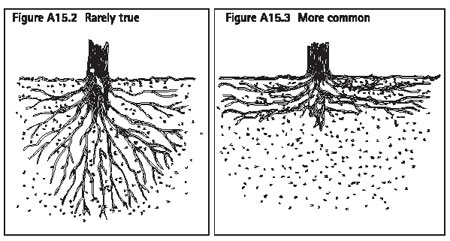
Figure A15.2 is how many people imagine tree root systems.
While a few species do have deep tap roots most do not. This notion
is more artistic than accurate.
Roots spread to where soil conditions provide nutrients
and moisture, which is usually near the surface. About 85 per cent of
tree roots are within the top 500mm of soil. Figure A15.3 shows the
lateral spread of roots which is more common.
Under ideal conditions tree roots can extend out from
the trunk two or three times the radius of the canopy spread (dripline)
or two or three times the height of the tree. The canopy spread (dripline)
is ideally the minimum area around a tree which should be protected.
2.2.2 Typical
root systems
Typical root systems are made up of a combination of
four types of roots:
-
major lateral roots
-
sinker roots
-
woody feeder roots
-
non-woody feeder roots.
Major lateral roots originate from the base of a tree
trunk. These roots exist near the soil surface, and grow outward in
a radial, horizontal direction. Figure A15.4 illustrates basic tree
function.
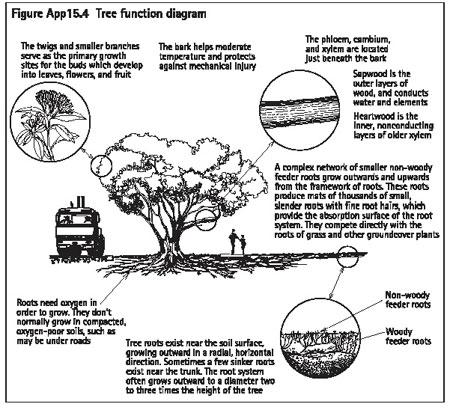
Sinker roots grow vertically downward from the lateral
roots, providing additional anchorage and increasing the depth to which
the root system penetrates. Sinker roots are usually found within a
short distance of the tree trunk.
Major lateral roots and sinker roots provide the primary
anchorage for a tree. These roots usually do not extend below one to
two metres in depth.
Woody feeder roots extend from the lateral roots, and
are typically located in the upper 300mm of soil.
Non-woody feeder roots grow well beyond the canopy,
greatly increasing the absorption area of the root system.
2.3 Wound response
Damage to trees, unlike damage to light poles and pavement
cannot be repaired. Trees are living organisms, but they do not heal.
Damaged tissues are not replaced and restored with new cells. Damaged
areas are physically closed off from undamaged areas, and the damaged
tissue remains within the tree for the rest of its life.
The defensive reaction to wounding and the spread of
decay requires a redirection of energy resources. Each time a tree responds
to wounding results in a loss of energy which could have been used for
healthy normal growth.
The amount of energy lost to wound response depletes
the total available energy. Continued normal growth is no longer possible
and repeated, extensive wounding can stress a tree to the point of decline.
3.0 Damage to trees
A resource consent must be obtained for any work to
cut, damage, alter, injure, destroy or partially destroy any scheduled
tree or generally protected tree (including roots). Expert advice is
available from council arborists to ensure the health and survival of
trees.
Trees are more vulnerable than many people imagine.
Special care must be taken on all sites where work is to be carried
out within the vicinity of trees that are to be preserved.
Damage to trees caused by construction work occurs both
above and below the ground. Root systems can suffer mechanical and chemical
damage. Tree trunks and crowns can be subject to various degrees of
mechanical and heat damage. These types of damage to trees can be serious.
These types of damage to trees can also be prevented.
Understanding the seriousness of the damage is necessary
to understanding the value of preventing such damage
3.1 Above ground
damage
Many construction activities cause above ground damage
to trees. Damage above ground can be a result of direct impacts with
construction equipment and storage of construction materials against
trees. Trees can also be damaged by improper ‘pruning’ for
clearance by construction personnel. Figures 5 and
6 illustrates these
points.
3.1.1 Trunk and crown
damage
Trunk and branch wounding can range from minor outer
bark damage to total structural failure of the main stem. Damage to
the phloem, cambium, and xylem disrupts the flow of water, mineral elements,
growth regulators, and photosynthates (sugars) between the crown and
roots. The greater the circumferential damage, the greater the total
amount of flow lost. Damage to wood tissues also reduces the availability
of previously stored food reserves, and the amount of woody tissue available
for future food storage.
Trees must also redirect resources to close the large
wounds, furthering net energy loss. The exposed wood tissues at wounds
provide open access for wood rotting fungi. Trees stressed or weakened
by construction damage may also be predisposed to secondary insect and
disease infestations.
When large branches are torn away from trees the damage
is substantial. Loss of major limbs reduces the quantity of leaf area,
thereby reducing the tree’s total photosynthate (sugar) production.
Total leaf area is also reduced by leaf scorch and twig
death. This occurs when hot exhaust gases vent from equipment operating
beneath tree crowns.
Heat and fumes can kill or injure the trunks, branches
and leaves, reducing the trees ability to survive (See figure A15.5).
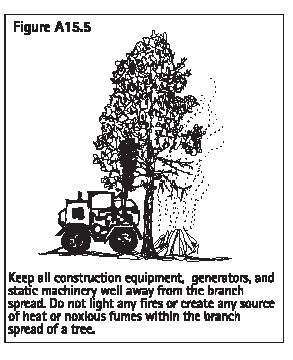
3.2 Below ground
damage
Tree roots often suffer extensive injury and loss as
a result of construction work happening around them. The main causes
of construction damage below ground are:
-
soil compaction
-
direct root loss
-
soil grade changes
-
chemical contamination.
3.2.1 Soil compaction
The soil within the root zone of a tree can suffer compaction
damage by general construction traffic, operation of heavy equipment,
and by the storage of construction materials within the root zone. The
soil may also be intentionally compacted as an engineering requirement
of construction. See figures A15.6 and A15.7.
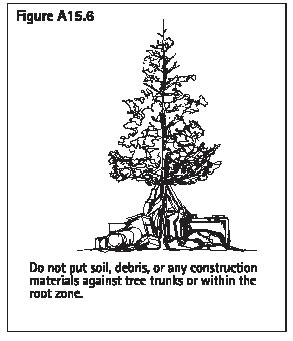
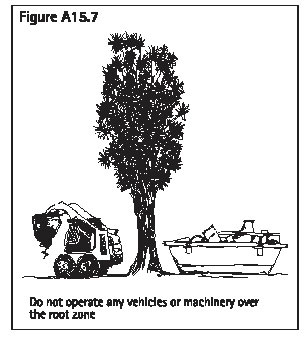
Compaction of the soil changes soil structure and increases
bulk density. This causes a decrease in supplies of oxygen necessary
for root respiration, an accumulation of carbon dioxide and other toxic
gases, and affects water infiltration rates.
Some soil types become more impervious to water, and
others retain more water. This leads to either drying or water-logging
of soils surrounding tree roots. Such changes in soil moisture can cause
direct root mortality.
Abnormal soil moisture and compacted soil structure
can also prevent roots growing into new areas.
Symptoms of compaction may not be immediately obvious
and trees may die several years after compaction damage has occurred.
Although you may have seen healthy trees growing in
areas covered by impervious materials (such as concrete or asphalt)
these trees have usually grown under such conditions since they were
saplings. Mature trees may be killed by new surfacing.
Seek any necessary consents and advice of a qualified
arborist before installing hard surfaces over the root system of any
scheduled or otherwise protected trees.
3.2.2 Direct
root losses
Excavating and trenching machines are commonly used
in construction. This equipment has the potential of causing extensive
root loss when no concern is given to root systems during trenching
and excavating activities.
Roots can be severed, torn away, or crushed causing
serious wounding and loss of normal structural stability. This can lead
to direct tree mortality and/or uprooting. Less severe damages may lead
to drying out, and death of exposed roots. Roots that are badly damaged
are prone to decay pathogens. The physical loss of roots will affect
the trees stability and ability to survive, and may lead to a decline
in tree health. See figure A15.8.
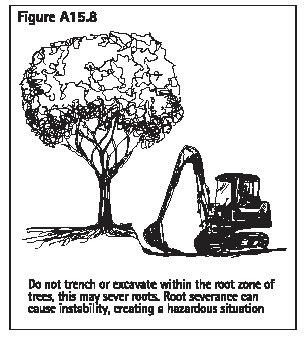
3.2.3 Soil grade
changes
Leveling, filling, and cutting of soil grades will result
in the same types of damaged associated with excavating, trenching,
and soil compaction. Grading may also remove the nutrient-rich topsoil
that supplies basic elements trees require for growth. See figure A15.8.
Lowering or cutting grades can remove a large percentage
of feeder roots. Raising or filling grades around trees reduces air
diffusion and exchange in the root zone. As little as 100 mm of soil
placed over the established root systems of some species is enough to
kill them.
Even if grade changes are not made directly in the root
zone they may be close enough to root systems to affect water drainage.
Again, this may cause root dieback due to changes in soil moisture content.
3.2.4 Chemical
damage
Leaking or spilling of fuel, lubricants or hydraulic
oils, or intentional dumping of masonry resinates, paints, acids, solvents,
or any other toxic substances may kill roots or impede their functions.
When such toxins are deposited in tree root zones they adversely affect
tree health or directly cause tree mortality. See figure A15.9.
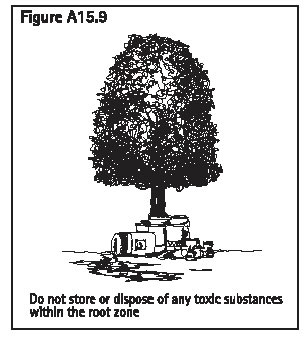
4.0 Protection and
care of trees
Trees should be protected on the work site by defining
an appropriate area around them, and by excluding all construction operations
from the protected area.
The success of the tree protection process will depend
on the cooperation of all persons involved in the design, construction
and implementation of the protective measures.
It is essential for those involved in the siteworks
to appreciate the need for maintaining the area of protection around
trees. Breaching the protective zone can easily lay to waste the time,
effort and expense which has gone into the protection of the trees.
4.1 Protective
fencing
Before any materials or machinery are brought on site,
or before any demolition, or development begins protective fencing must
be erected around all trees which are to be retained. Trees on adjacent
properties affected by the construction works must also receive appropriate
protective fencing. See figure A15.10.

The fencing must be strong and appropriate to the degree
of construction activity taking place on the site.
The protected area around trees must be of dimensions
recommended in figure A15.11. The temporary fencing around this area
must be maintained throughout construction works. The temporary fencing
shall be 1.8 - 2m high and must prevent access within the protected
area.
No works shall be carried out within the protected area.
No materials shall be stored within the protected area.
Notices should be erected on the fencing with words
such as ‘Protected area - no operations within fenced area’.

4.2 Installation
of utility services
Detailed plans are required to show the routing of all
services in the proximity of trees, and must indicate the area needed
for installation of the services.
Care is also needed in routing above ground services
to avoid excessive pruning requirements before or after the installation
of services.
If an alternative route can not be used then the installation
of underground services must be done in a way that minimises damage
to trees, for example using techniques such as thrusting and/ or hand
digging.
Open cut trenching can cause major damage to tree roots,
as shown in figure A15.12a. Thrusting minimises and localises damage
to tree roots, as shown in figure A15.12b, and is the preferred method
of service installation.
4.2.1 Thrusting and
directional drilling
Traditional methods of service establishment (ie open
cut trenching) can cause massive root damage and ground disturbance
therefore the ‘change of environment’ for the tree will
be high.
The action of ‘thrusting’ or ‘directional
drilling’ is the most preferred method of service establishment
within the dripline of trees. When these two methods are used, the ‘change
of environment’ around the tree is minimised.
All machinery and starting pits associated with the
action of thrusting or directional drilling should remain outside the
dripline of trees. This is to minimise any root loss or ground compaction
that may arise from the works.
If the thrusting rod or directional drill-head becomes
stuck underneath the dripline of a tree, then the arborist responsible
for the trees on the site should be contacted prior to the retrieval
process. Any retrieval of a thrusting rod or directional drill-head
under the dripline of a tree should be undertaken with hand tools unless
otherwise stated by the arborist responsible for the trees on the site.

4.3 Hand digging
The excavation method of ‘hand digging’,
if carried out correctly, has the potential to have a ‘no more
than minor’ effect on the health and safety of the tree/s which
are within the line of works. The objective of hand digging is to retain
the majority of roots.
Great care should be taken when hand digging within,
or close to, the dripline of a tree. Works should be undertaken with
due care and attention. The more time and care spent on hand digging,
the less impact the work will have on the health and safety of the tree.
The main motivation for using hand digging as a method
of excavation is root retention. When digging within the dripline of
a tree, carefully remove the soil making sure that any roots accidentally
discovered are not repeatedly hit or severed. Take care not to damage
the outer ‘bark’ of roots as this is the area where the
transport of nutrients and water to the rest of the tree occurs.
Fact: Hand digging takes time. Allow enough time for
this method of works to occur when planning your job. If there is a
lot of hand digging to be done on your site, train up a specialist crew
who will become skilled in this method of excavation and therefore reduce
the time that is required to achieve the work.
The majority of the roots are usually found near the
soil surface. It may be possible to excavate by hand to a certain depth
and then, in the absence of any roots that are to be retained, excavation
by another method may be possible.
Prior to the work occurring, seek advice from the arborist
responsible for the trees on the site as to how to proceed with the
method of hand digging.

